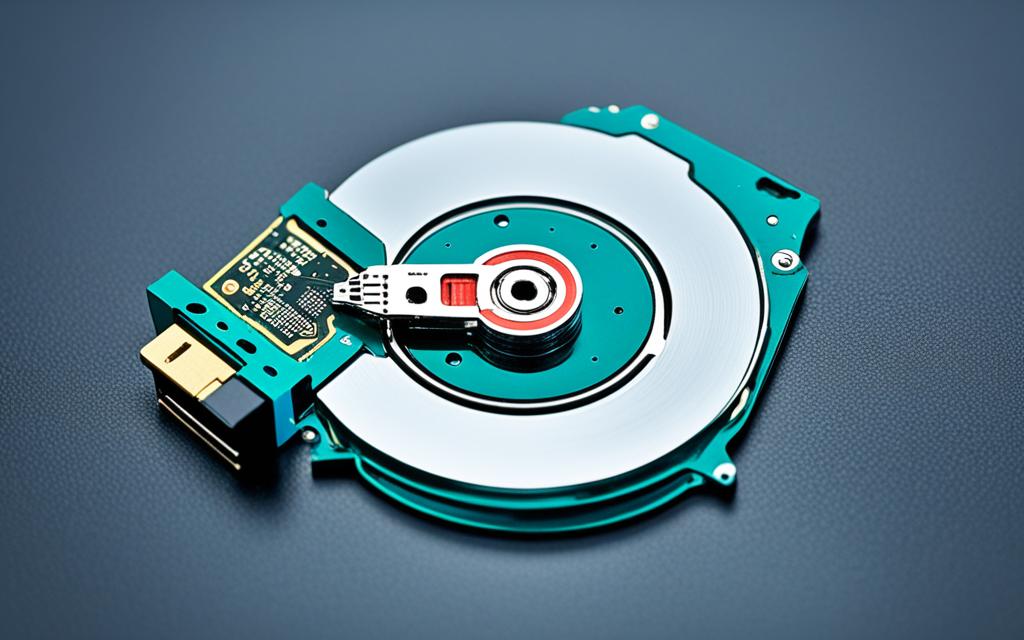Table of Contents
Write protection stops users from changing or deleting files on their hard drives. This can be especially annoying for those who need flexibility with their data. HDDs become write-protected for various reasons. Issues like virus attacks, a damaged file system, or wrong settings in the Windows Registry are common culprits12. It’s essential to understand these causes to remove write protection. By doing so, you can freely manage your data again. Our guide will explore how to unlock HDDs and get them working fully.
Key Takeaways
- Write protection stops changes to files on your HDD.
- Problems that lead to write protection include viruses and faulty systems.
- Unlocking your HDD can be done with tools like CHKDSK or Diskpart.
- Changing Windows Registry settings can also remove write protection.
- Certain devices have switches to control write protection.
Understanding Write Protection
Write protection, also known as read-only protection, is key in keeping data safe. It stops anyone from changing or deleting information on a hard drive. Knowing what is write protection helps us see its value in saving crucial data, especially when moving it around.
This type of protection can be physical, like a switch on portable drives. This lets users turn it on or off easily. Many USB flash drives have such a switch, showing the tangible aspect of write protection definition. On the other side, virtual write protection is done via software. It prevents actions such as copying or deleting files when it’s on.
Sometimes, write protection errors can be annoying, especially if you need to change locked data. These issues can come from security steps or by accident through malware. This does not stop you from viewing the data, which shows how write protection works both ways.
However, just turning on write protection isn’t enough to stop all threats, like viruses or data loss from power issues3. So, it’s important to understand what is write protection fully to manage your data well.
Common Causes of Write Protection
Learning about the causes of write protection on hard drives helps us fix write protection issues. This issue comes from different sources, including:
- Virus or Malware Infections: These can change drive settings, causing unwanted write protection.
- Corrupted File Systems: This often leads to write protection, making the drive unreadable for changes. More than 40% of these problems are due to corruption, making it a common issue4.
- Incorrect Registry Values: Wrong settings in the Windows Registry can also trigger write protection, stopping changes.
- Encrypted Drives: Secure encryption can prevent data editing unless access is authorised. This scenario is seen in over 30% of encrypted drive issues5.
- Bad Sectors: Physical flaws or damaged areas on the drive can restrict it to read-only. Such damage plays a large role in write protection cases6.
It’s vital to pinpoint the real causes of write protection. This understanding directs users to the correct fix. Solutions might include using recovery software or checking disk health and settings.
How to Remove Write Protection from HDD
Facing write protection on your HDD can be frustrating. It limits your ability to store or access data. Here are three effective techniques to remove write protection from your hard drive.
Using the Diskpart Command
The Diskpart command is a useful tool in Windows for managing disks and partitions. To use this method, follow these steps:
- Open the Command Prompt as an administrator.
- Type “diskpart” and press Enter.
- Enter “list disk” to see all connected drives.
- Select the disk with issues by typing “select disk X”. Replace X with your disk number.
- Type “attributes disk clear readonly” to try and remove the write protection.
This command helps many, especially with external drives like WD models. It has shown success for those with similar problems7.
Editing the Windows Registry
Another method is to edit the registry. Be careful, as wrong changes can lead to system problems. To do this:
- Press Windows + R, type “regedit”, and hit Enter.
- Navigate to HKEY_LOCAL_MACHINE\SYSTEM\CurrentControlSet\Control\StorageDevicePolicies. Create it if it doesn’t exist.
- Change the “WriteProtect” key value to 0 to disable the protection.
Altering the registry is advised when other methods don’t work8.
Using CHKDSK Utility
The CHKDSK utility checks and fixes disk errors. It’s an important step in solving write protection issues. To use CHKDSK:
- Open Command Prompt as an administrator.
- Type “chkdsk X: /f” replacing X with your drive letter, then press Enter.
This might solve issues making your disk read-only. It can improve your disk’s ability to store data9.
Alternative Solutions for Write Protection Removal
Various innovative methods can tackle write protection challenges effectively. These alternatives streamline the process and improve user experience significantly.
Using a Third-Party Partition Manager
A tool like AOEMI Partition Assistant Standard helps with alternative write protection removal. It makes disk management easy, especially on Windows systems like Windows 11, 10, and more. Users often find success with this software when other methods fail. Remember, formatting to remove write protection deletes all data. So, it’s wise to back up your information first.
Checking for Drive Encryption
Drive encryption can trigger write protection alerts. This happens often with BitLocker on Windows, leading to confusion. Checking encryption settings helps understand and fix access issues. Learn more about overcoming these problems.
| Method | Effectiveness | Eadh of Himemade |
|---|---|---|
| Physical Lock Switch | High | Very Easy |
| Diskpart Command | Moderate | Moderate |
| Third-Party Tools | High | Easy |
| Registry Editing | Low | Difficult |
| Disable BitLocker | High | Moderate |
Third-party partition managers are often the top pick for beating write protection, as well as dealing with drive encryption. These tools streamline the process and offer quick solutions318.
Conclusion
Write protection keeps your data safe. Yet, it can cause headaches when you wish to change or delete files. By knowing why write protection happens, you can find ways to fix it. This includes using tools like Diskpart, changing the Windows Registry, or using AOMEI Partition Assistant.
AOMEI Partition Assistant has special tricks up its sleeve. It can change NTFS to FAT32 without losing data and fix broken drives10. Also, the 4DDiG data recovery software is great for getting back data from secure or write-protected devices. It makes sure your important files are safe11.
To dodge write protection troubles in the future, always back up your stuff. Also, stay on the lookout for viruses. Taking these steps moves you towards a better experience with your HDDs. It also helps you keep your essential data intact.
FAQ
What is write protection on a hard drive?
Write protection means you can’t change data on a hard drive. You can only read it. This keeps the data safe.
What causes write protection on my hard drive?
Many things can cause it, like viruses or errors in the drive. Even small mistakes in settings can turn it on.
How can I remove write protection from my hard drive?
To remove it, you can use Diskpart command, tweak the Windows Registry, or run CHKDSK. Each method fixes different problems.
Are there alternative solutions for removing write protection?
Yes, for tricky cases, try a third-party partition manager. Or check if your drive is encrypted as another solution.
Is it safe to disable write protection?
It’s usually safe if you ensure the data is okay and backed up. This avoids losing or accidentally changing important files.
Q: How do I check if my hard drive is write-protected?
Try to edit or delete a file. If there’s a read-only error, then it’s likely write-protected.
Can write protection be hardware-based?
Indeed, some external drives have a switch for it. Make sure the switch is right for writing.
Source Links
- https://www.diskpart.com/articles/remove-write-protection-from-hard-drive-0310.html – Effective Four Ways to Remove Write Protection from Hard Drive
- https://smallbusiness.chron.com/disable-write-protection-hard-drive-54089.html – How to Disable Write Protection on Hard Drive
- https://community.wd.com/t/how-to-remove-write-protection/499 – How to remove write-protection
- https://www.stellarinfo.com/blog/solved-unable-to-remove-write-protection-from-hard-drive/ – How to Remove Write Protection from Hard Drive in Windows [SOLVED]
- https://www.systoolsgroup.com/how-to/remove-write-protection-from-external-hard-drive/ – Remove Write Protection From External Hard Drive Windows 10 (Solved)
- https://www.easeus.com/partition-manager-software/remove-write-protection-from-external-hard-drive.html – 5 Ways | Remove Write Protection From External Hard Drive
- https://www.techsupportforum.com/threads/solved-how-to-remove-write-protection-on-a-wd-external-drive.745513/ – [SOLVED] How to remove write protection on a WD external…
- https://www.easeus.com/storage-media-recovery/remove-write-protection-in-windows-10-8-7.html – The Disk Is Write Protected Remove Write Protection from USB
- https://www.linkedin.com/pulse/3-easy-ways-remove-write-protection-from-internal-external-disuza – 3 Easy Ways To Remove Write Protection From Internal & external Hard Drives
- https://www.diskpart.com/articles/format-write-protected-disk-7201.html – 3 Methods to Format Write-protected Disk in Windows 11/10/8/7
- https://4ddig.tenorshare.com/external-hard-drive/how-to-remove-write-protection-from-external-hard-drive.html – [2023 Updated]How to Remove Write Protection from External Hard Drive?








